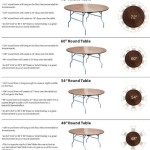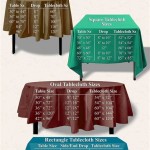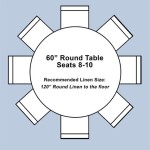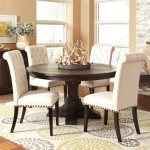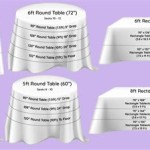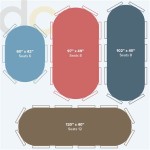Seating Plan Template: Round Tables
Creating a seating plan is a crucial aspect of event organization, whether it be for a wedding, corporate gala, or a large family celebration. A well-thought-out seating arrangement contributes significantly to the overall atmosphere and ensures guests feel comfortable and connected. When planning for an event utilizing round tables, a dedicated seating plan template becomes invaluable. This article will explore the nuances of using round table seating templates, highlighting their benefits, key considerations, and providing practical advice for their effective implementation.
Round tables are a popular choice for events due to their capacity to foster conversation and encourage interaction. Unlike long rectangular tables, round tables allow guests to easily see and speak with everyone seated, creating a more inclusive and communal dining experience. However, this inherent advantage also presents unique challenges when devising a seating plan. Factors such as sightlines, proximity to speakers or entertainment, and the dynamics between guests must all be carefully considered. A template helps to visualize these factors and optimize the seating arrangement for maximum guest comfort and enjoyment.
A seating plan template, specifically designed for round tables, is a visual aid that allows event organizers to map out the seating arrangement in advance. This template typically consists of a diagram representing the layout of the room, with circles indicating the position of each round table. Within each circle, spaces are provided to denote the placement of individual seats. The template may be digital or physical, depending on preference and availability of resources.
Benefits of Using a Round Table Seating Plan Template
Employing a seating plan template for round tables offers several distinct advantages that contribute to a smoother and more successful event. These benefits extend beyond simply assigning seats; they encompass efficiency in planning, improved guest experience, and reduced stress for the organizer.
Firstly, a template provides a clear visual representation of the final seating arrangement. This allows event organizers to assess the overall flow of the room and identify potential issues, such as overcrowding or blocked pathways. By viewing the entire seating plan at a glance, adjustments can be made proactively to ensure a comfortable and functional space for guests.
Secondly, using a template facilitates the process of assigning guests to specific tables and seats. Instead of relying on guesswork or last-minute decisions, organizers can systematically consider guest relationships, preferences, and any special needs. This ensures that guests are seated with individuals they know and enjoy spending time with, fostering a positive and engaging environment. A template allows for easy experimentation with different seating combinations until the optimal arrangement is achieved.
Thirdly, a well-prepared seating plan, generated from a template, minimizes confusion and delays on the day of the event. Guests can easily locate their assigned table and seat, reducing the likelihood of bottlenecks and frustration. This also allows event staff to efficiently guide guests to their designated places, contributing to a smooth and organized event flow. Furthermore, a clear seating plan enables catering staff to easily identify guests with dietary restrictions or specific requirements, ensuring a seamless dining experience for all attendees.
Finally, a seating plan template serves as a valuable communication tool between the event organizer and other stakeholders, such as the venue staff, caterers, and decorators. By sharing the seating plan, everyone is on the same page regarding the layout and guest assignments, minimizing the risk of miscommunication and errors. This collaborative approach ensures that all aspects of the event are aligned and coordinated, contributing to a polished and professional outcome.
Key Considerations When Using a Round Table Seating Plan Template
While a seating plan template provides a valuable framework for event planning, it is essential to consider several key factors to ensure its effective implementation. These considerations relate to table size, guest dynamics, sightlines, and accessibility, all of which contribute to a positive guest experience.
The size of the round tables is a crucial determinant of seating capacity. It is important to accurately determine the diameter of the tables and the corresponding number of seats that can be comfortably accommodated. Overcrowding tables can lead to discomfort and restricted movement, negatively impacting the dining experience. Conversely, tables with too few guests may feel sparse and lack the desired level of interaction. The seating plan template should accurately reflect the size of the tables to ensure optimal guest placement.
Guest dynamics play a significant role in creating a harmonious atmosphere. Careful consideration should be given to the relationships between guests when assigning seats. Seating individuals who know each other and share common interests can foster conversation and create a more enjoyable experience. Conversely, seating guests who are known to have conflicting personalities or beliefs should be avoided. The seating plan template provides a valuable tool for visualizing these relationships and making informed decisions about guest placements.
Sightlines are another important consideration, particularly for events with speakers, presentations, or entertainment. It is essential to ensure that all guests have a clear view of the stage or focal point. Avoid placing tables in areas where sightlines are obstructed by pillars, decorations, or other obstacles. The seating plan template can be used to assess sightlines from different table positions and make adjustments accordingly. Consider rotating tables slightly or rearranging the layout to optimize viewing angles for all guests.
Accessibility is a critical aspect of event planning, and the seating plan should accommodate guests with disabilities or mobility limitations. Ensure that there are designated tables near entrances and exits for guests who may require easier access. Provide ample space between tables and chairs to allow for wheelchair maneuverability. The seating plan template should clearly indicate accessible seating options and pathways to ensure a comfortable and inclusive experience for all attendees. Communicate with guests in advance to identify any specific needs and make appropriate accommodations.
Finally, the overall aesthetic of the seating arrangement should be considered. While functionality and guest comfort are paramount, the seating plan should also contribute to the overall visual appeal of the event. Consider the placement of tables relative to each other and to other elements, such as floral arrangements, centerpieces, and lighting. The seating plan template can be used to experiment with different layouts and create a visually pleasing arrangement that enhances the ambiance of the event.
Practical Advice for Using Round Table Seating Plan Templates
Beyond the core benefits and considerations, several practical tips can enhance the effectiveness of round table seating plan templates. These tips address the logistical aspects of creating and implementing the plan, ensuring a smooth and successful execution.
Begin the seating plan process well in advance of the event. Avoid leaving it to the last minute, as this can lead to rushed decisions and potential errors. Start by gathering information about the guest list, including relationships, preferences, and any special needs. This information will serve as the foundation for creating the seating plan. Using the template early allows for multiple iterations and adjustments as needed.
Utilize technology to streamline the seating plan process. Numerous software programs and online tools are available that offer pre-designed round table seating templates and features for managing guest lists and assigning seats. These tools can significantly simplify the process and improve accuracy. Explore different software options to find one that suits the specific needs of the event and the user's level of technical expertise. Cloud-based options allow for easy collaboration among event organizers and stakeholders.
Consider using visual cues on the seating plan template to differentiate between different types of guests or table assignments. For example, use different colors or symbols to indicate guests with dietary restrictions, VIP guests, or members of the wedding party. This visual coding can help event staff quickly identify and address specific needs. A clear legend should be included on the template to explain the meaning of each visual cue.
Print multiple copies of the seating plan template for different purposes. Provide a copy to the venue staff for setup and coordination, a copy to the catering staff for meal service, and a copy to the event coordinator for guest management. Having multiple copies ensures that everyone is on the same page and can easily access the information they need. Digital copies should also be readily available for easy access and sharing.
Be prepared to make last-minute adjustments to the seating plan. Unexpected circumstances, such as guest cancellations or changes in arrival times, may require adjustments. Have a contingency plan in place for handling these situations and be prepared to make quick decisions. A flexible seating plan template allows for easy modifications without disrupting the overall arrangement. Keep a few unassigned seats available to accommodate any unforeseen circumstances.
Clearly communicate the seating plan to guests in advance. Provide guests with table assignments on place cards or through a seating chart displayed at the entrance of the event. Ensure that the table numbers or names are clearly visible and easy to read. Consider using a digital seating chart that guests can access on their smartphones or tablets. This reduces confusion and helps guests quickly find their assigned seats. Provide assistance to guests who may need help locating their table.
Finally, solicit feedback from guests after the event to assess the effectiveness of the seating plan. Ask guests if they enjoyed their seating arrangement and if they had any suggestions for improvement. This feedback can be valuable for future event planning and can help refine the seating plan process. Analyze the feedback to identify any patterns or trends and make adjustments accordingly. Continuously strive to improve the seating plan process based on guest feedback and experience.

Free Table Seating Plan Templates

Blank Wedding Seating Charts 10 Free Printables Printablee

Free Printable Round Seating Chart Template For Weddings And Parties The Photo To Go Website A Version

Seating Chart Templates Estate Management Network

Wedding Seating Plan Template Planner

Printable Wedding Table Seating Chart Template Round Planner Event Arrangement Head Plans Seat Map

Seating Plan Chart 90 Pax Round Wedding Table Display For Guest Names Draft Seat Planner Instant Printable Planning

16 Table Seating Chart Templates Doc Excel

8 Person Round Table Seating Chart

16 Table Seating Chart Templates Doc Excel
Related Posts

